Text and photos: Katie Dubey
We were holidaying in Jaipur, when our friend sprang a surprise on us. “Anniversary gift for you two”, he announced, “I have booked you into Castle Mandawa tomorrow”. My husband’s jaw dropped, I burst into giggles, and our friend grinned like a Cheshire cat!
Next morning, while the sky remained colourless, the wind tossed sand on to the road and the pink city slumbered, we embarked on our 190 km drive to Mandawa, in the heart of the Shekhawati region of Rajasthan.
The Thar
Sand and sky is all there is. The Thar, generally called the Great Indian Desert, is the 17th largest desert and the 9th largest sub tropical desert region of the world. Indigenous vegetation occurs in small clumps. Some babul trees, yellowing scanty grasses and desert weeds, defy the wind and sand and cling to life.
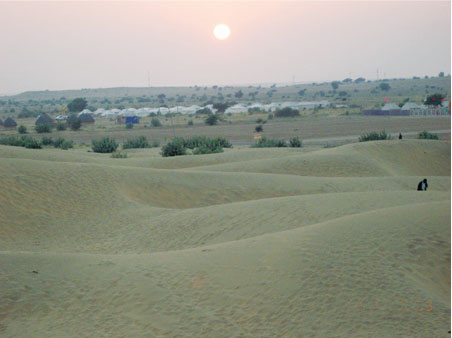
Crushing and cruel climatic conditions prevail. Temperatures dip below zero degree Celcius in winter and rocket over 50 degrees Celcius in summer, bringing waves of scorching hot air called the ‘loo’. The ‘loo’ smothers desert inhabitants. Scant rainfall affords only some relief to the land, and life goes on. About 23 species of lizards and 25 species of snakes thrive, several of them endemic to the area. Wildlife species, disappearing in other parts of India, survive here in large numbers, like the blackbuck.
The importance of the Shekhawati region
Shekhawati is a convenient term to describe three modern districts of Rajasthan that cover an area of about 30,500 sq km; surrounded by Jangladesh, Haryana, Mewar, Dhundhar, Ajmer and Marwar. Fertile and well watered on the eastern fringes, westward the land becomes a desert of rolling, drifting sand dunes interspersed with low grade millet fields, and sparse grazing for sheep and goats. The jagged chain of the Aravalli Hills lying east of the region, and rising to 3,000 ft, block precipitation to the west.
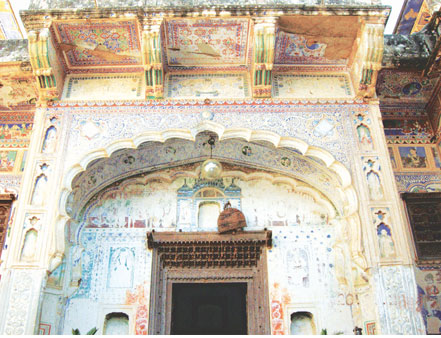
Shekhawati formed the physical border between two desert kingdoms, Jaipur and Bikaner. In the 18th century, this region also drew a timeline between two empires; a rapidly declining Mughal empire, and a speedily rising British Empire. The interregnum saw the first mural paintings adorn the walls in Shekhawati.
Mural art – the pride of Shekhawati
Through the machinations of history, an impoverished corner of an arid region in the desert came to hold the most highly embellished structures with the largest concentration of mural art the world has ever seen. Not only are the outer walls of every home covered in murals, but also the inner ones, along with every structure; monuments, mansions, temples and step-wells.
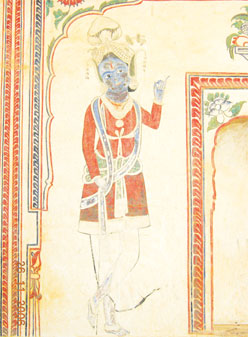
The seeds for these paintings were sown in the ateliers of the Mughal court of Emperor Akbar. He induced artisans and painters from Persia to settle in India: First in Agra, and then in Fatehpur Sikri, where he had moved his capital for a short while. Here, the new school of mural paintings emerged. The Mughals prepared the soil for mural paintings, but prevented the seeds from germinating. It supported only the local Muslim nawabs, who were too terrified by religious taboos to indulging in artistic adornment. Art was thus left to the Emperor alone.
Two Hindu nobles held the territories surrounding those of the nawabs. These were later destined to become an outstanding “outdoor art gallery”. A century passed. The Mughal Empire was wilting. Beleaguered and threatened by the British, it faced pressing issues. The fate of a group of minor Muslim nawabs on the outskirts of their kingdom, surrounded by Hindu-ruled territories, amongst whom were the Shekhawat Rajputs, who held all of lands east of the Aravalli Hills, was not of much interest to the Mughals at this jucture.
A Rajput revival of militancy occurred during the reign of the last Mughal emperor, Aurangzeb. They encroached through the hills and expanded their territorial holdings displacing the Muslim nawabs. Shekhawat’s expansion accelerated, until, in 1732, the conquest was complete. The Nawabs of Fatehpur and Jhunjhunu were vanquished and two Shekhawat Rajputs, Shardul Singh and his cousin Shiv Singh were installed on the conquered land.
On their desert estates, the nobles had only two sources of income. They taxed farmers on their generally pathetic harvests, and imposed duties on the merchandise crossing their borders. Camel-borne goods were the only form of trade in the desert and a major part of the economy. A small merchant community oversaw the local commerce.
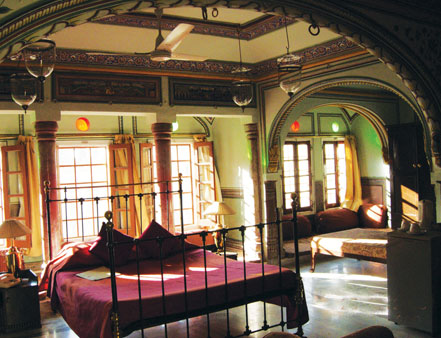
In an era of strife, which the 18th century was, each prince found it difficult to fill his coffers. The Rajas of Bikaner and Jaipur tried every means to raise funds. Along with other rulers they raised tariffs on trade. Totally, their kingdoms spanned the whole of north Rajasthan, except for the narrow corridor belonging to the Shekhawats, who though vassals, remained independent and set their own rates. This meant that a caravan crossing through Shekhawati may have to pay several times, but, the rate was still lower than that levied by Jaipur and Bikaner. So, merchants preferred the circuitous route.
From the turn of the century until 1822, a vast amount of trade passed through Shekhawati and Marwari businessmen were attracted to the region. These men and their descendants were later to finance the majority of murals characteristic of Shekhawati, their prosperity enhanced by the deflection of trade. Some of the money they earned went towards building temples, memorials and mansions.
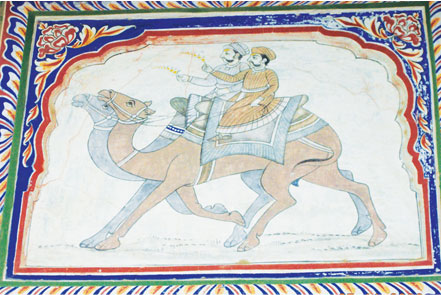
But, the days of flourishing cross-desert trade were numbered. If it had merely been disrupted by growing banditry, then its repression by the Shekhawati Brigade during the 1830’s would have brought relief. But, no such thing happened. The British profoundly affected the traditional pattern of trade. The ports of Calcutta and Bombay handling large European vessels overshadowed the small ports of Gujarat. Their tariffs, designed to establish monopolies for the East India Company, made some established routes unviable and their pressure on the Jaipur Court for reduction of duties rang the death knell for the Shekhawati trade route.
Unfazed, the Marwaris shifted their businesses to Calcutta, flourished and amassed huge fortunes. News spread to Shekhawati, bringing more men from desert towns to Calcutta. By the close of the 19th century, the economic power of the Marwaris in Calcutta was phenomenal. Several of the migrants began ploughing money back to Shehkawati, into their ancestral properties. From that time on, they completely eclipsed the Rajputs in power and pomp.
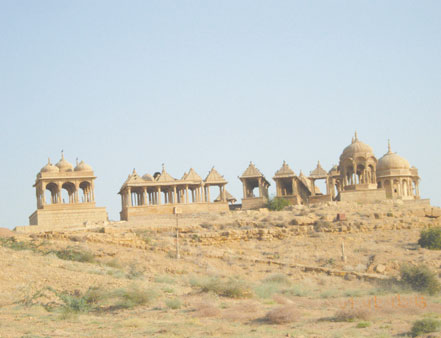
In the 18th and 19th centuries, Marwari merchants constructed grand havelis in the Shekhawati region. Steeped in wealth and affluence, these merchants got busy outdoing each other in building grand edifices. They financed painting and architecture in Shekhawati, maintaining their status in their hometown. As the century progressed, mansion or memorial, temple or well, every building was covered with paintings. When famine struck Shekhawati, they poured in more money. Their relief projects took the form of yet more palatial buildings embellished with yet more paintings. Each building was an expression not merely of affluence, but also of confidence in a new era of stable government.
Initially, the pictures were limited to panels between the stone brackets which supported the projection of an upper story over the lower façade. Soon they spread to any surface worthy of becoming a canvas. Outer walls, inner courtyards, sitting rooms, bedrooms – all received the painters’ attention. Up to the early 19th century, the themes were largely religious. Later, historic events, personages, battle scenes, and folk heroes or whatever caught the artist’s fancy, was also painted in great detail. Later, cars, trains, airplanes, ships, telephones, foreigners in hats, suits and gowns began to appear on the walls along with scenes from Lord Krishna’s life. The paintings acquired historical value portraying the changing times.
Extravagant buildings sprang up in the 1830’s and continued into the early years of the 1900s, transforming a large part of Shekhawati into a “desert gallery”. Fine architecture was not unknown to the region. The Shehkawat Rajputs had built and so had the Kaimkhani nawabs before them. Much earlier, in the 10th century, under the Chauhan Rajput rule, the beautifully carved temple of Harshnath had been constructed on a hill-top near Sikar. Handsome buildings were not new, but the sheer burst of output in terms of quantity and quality in Shekhawati surpassed anything done earlier.
The origin of Shekhawati
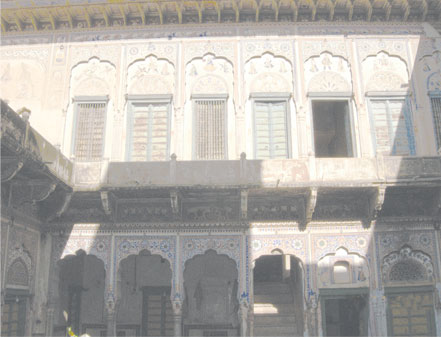
Legends thrive in India, particularly in small towns. One legend talks of Shekhawati being under the sea in pre-historic times. According to geologists, the presence of fossil forms found in the stone formations here are sufficient evidence to prove the theory. What remains a mystery is what caused the sea to recede, leaving arid land in its wake. The region also finds a mention in texts as ancient as the Rigveda, Manusmriti and the Ramayana. It was then the Matsya kingdom, and extended up to the Saraswati River, not limited to the two present day districts.
The more cognisable story is that of Mokul Singh, the ruler of Barwada in the 15th century. Lacking an heir, he retired to Vrindavan, the land of Lord Krishna, to live in austerity. Pleased with his devotion, his guru granted him a boon. He asked for a son.
Mokul was asked to return to his principality and graze cows in a designated area and worship Gopinathji, Lord Krishna, as lord of the gopis. Having done this, a son was born to Mokul Singh whom he named Shekha. When only 12 years of age, Shekha inherited his father’s estates. During the 15th century, he conquered and held a considerable amount of territory in this region of Rajasthan and the lands he conquered came to be called ‘Shekhawati’. Gopinathji is the region’s reigning deity.
Given the nature of Shekhawati, building materials could not be transported over any great distance easily. There were few stretches of road, and even these were rendered un-usable when covered with shifting sand. Camels or bullocks were used for transport. No first class stone was quarried nearby. The fine red sandstone quarried to the west of Churu, was too far to be of use during the building boom. The carved stone elements – brackets, pillars and decorative panels – seen in local buildings, were all quarried at the foot of the Aravalli Hills, particularly at Raghunathgarh. For the walls, three materials were used, depending on their availability – brick, stone fragments and a hardpan material, dhandhala.
Away from the hills, brick was used. Closer to them, in towns like Jhunjhunu, Khetri, Singhana and Udaipur, stone fragments. In the central areas, dhandhala which were grayish lumps of hardpan. Many of the best painted towns are in the dhandhala belt.
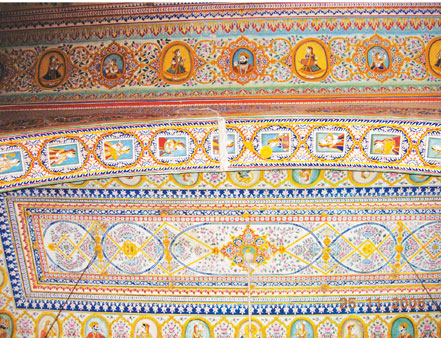
Timber, rare in the desert, has only one source – the ‘rohaira’ tree large enough to provide timber for fine woodwork in forts and havelis.
The fort and havelis of Mandawa
As always, the town came to be known by the name of its originator – Mandu. Mandu Jat, established a dhani – a hamlet, and dug a well here in 1740 AD. The village was known as ‘Mandu ki dhani’. Gradually, it evolved into ‘Mandawa’.
Located in the centre of the Shekhawati region, it grew into a trading outpost for the trading caravan routes that traversed the desert from China, Middle East and parts of India. In 1756, Thakur Nawal Singh, who ruled Navalgarh and Mandawa, built a fort here to protect this lucrative post. With protection comes security and in no time at all, more traders came to Mandawa and settled here. A township evolved. But, the Thakur’s family did not inhabit the fort until the very end of the 18th century, when Naval Singh’s grandsons, Padam Singh and Gyan Singh came over to Mandawa from Navalgarh. Originally a walled city, today little remains of its defences, but in 1828, when the combined forces of Jaipur and Sirkar attacked the fort, it successfully withstood the siege for an entire week.
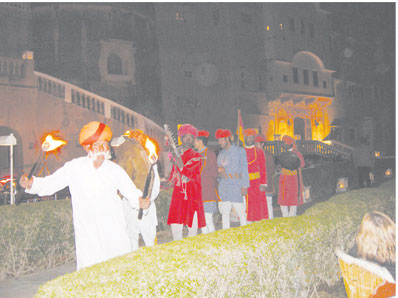
The fort is the mainstay of the town and built in the medieval style. It has a painted arched gateway, adorned with images of Lord Krishna and his cows over a single gate.
Forts were built by the Thakurs on their Thikanas – ‘fiefdoms’ – to safe guard their holdings in a violence prone era. The fort was always established on the highest elevation available so as to give the lookout a clear view of anyone approaching it. They were all functionally built on a square plan with a thick wall and sometimes a moat surrounding it.
The road to Mandawa – a travelogue
The road was velvety; a narrow bitumen strip that cut through a landscape as flat and yellow as a pancake for the most part, relieved by rare patches of dirty green, where hardy xerophytic herbs had taken root and a strange creeper with fruit like small melons, crept stealthily along the sand in patches. On enquiring with the driver, I was told that camels ate this strange fruit.
The landscape hardly varied and as we neared Mandawa, got even more stark, if possible. By mid-morning, even though it was winter, the sun was burning an already scorched landscape. Protected by the air conditioning in the car we journeyed on, but at 1.30 pm, when pangs of hunger hit, it was hard to find a spot where one could halt awhile to eat the packed lunch. Driving down the treeless road, we finally did come to a spot where a large Prosopis juliflora bush cast a short shadow across the road. Under this welcome shade we finally halted for lunch. Prosopis juliflora was introduced in the desert to halt its march, but ironically, it is overtaking the desert itself! Lunch over, we moved on and around 3.30 p.m., entered through a maze of narrow streets, the castle town of Mandawa, centrally located in the Shekhawati region.
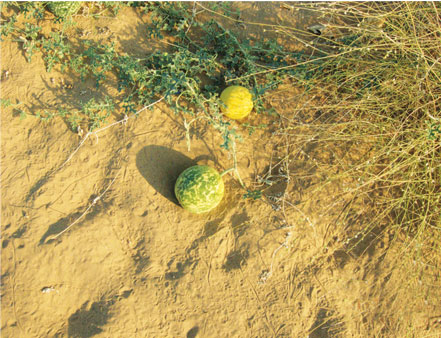
Our entry into Mandawa was uneventful. For a town of historical importance, it was sadly sleepy, fairly dirty and unkempt. Unimpressive in fact, with narrow winding streets between large mansions that were going to seed. The first haveli (mansion) that we came upon as we entered and which was in good shape, was the Goenka Haveli. The Goenkas remain a prosperous business group to date, and are well known to the public at large on account of the Indian Express, a well received newspaper throughout the country. Their haveli is prominently located along the road and well maintained. From this point on, wherever we turned, we encountered painted walls. Weaving in and out of narrow streets, checking with locals at every turn, we finally entered a slim alley that brought us before the massive gates of Mandawa Castle. As those gates were pulled open by a couple of liveried guards, literally in the blink of an eye, we were transported to another world and transformed to royalty.
The gates swung close, as our vehicle pulled up by the portico. The car doors were held open for us deferentially by more liveried personnel and as I stepped out of the car, indeed, I was a princess.

I found myself in what was once the durbar hall. It was so highly ornate that I felt distinctly uncomfortable taking a seat there, while check-in formalities were being completed. Two throne chairs occupied a central position. They were flanked by carved camphor chests and topped by enameled lamps. A large crystal chandelier hung from the ceiling and the walls were crammed with paintings and antiques while the arches were painted from end to end. The overall effect of this blend of eastern and western opulence was rather overwhelming. Even the low arch carried portraits that were obviously restored, and the work was in gold leaf, no less! I am told that no two rooms are the same here! How could they be in this maze, where rooms are tucked away at various angles? They have been remodeled to suit the modern tourist, but with its old world charm left untouched.
Formalities complete, we were shown to our room on the first floor via an extremely narrow stairway. As the staircase came to an end we had to double up under a really low arch that opened on to a terrace. Rooms fronted the terrace. The bellboy brought forth a bunch of huge keys and fitted one to the padlock of room 208. Then he flung open the wooden doors with a flourish and bowed us in. I don’t recall now if my jaw dropped at what was before me; a good sized room in which a carved four poster bed dominated. An enclosed verandah ran the length of the room along which was a narrow divan covered with woven silk and strewn with cushions of several sizes. Above the divan was a row of skylights of coloured glass that set the room aflame with varied hues. Granite pillars supported the low arches that were figure painted and framed with flowers. A coffee table, refrigerator and a few other pieces of furniture were inconspicuously, but elegantly placed in the room. A passing thought – I wondered how such massive pieces of furniture were hauled into the room given the narrow access? But there was much more to occupy my mind.
We gathered our cameras and were soon bending through the connecting arch and moving up to the battlements of the castle. Erected on a hillock, the castle dominates the town below as it is meant to. From the battlements we garnered a bird’s eye view of the town sprawling below. We clicked away!
We returned to the castle as dusk was setting in. A messenger came to the door to inform us that dinner would be served on the spreading, manicured lawns; His Highness Bhim Singhji, current owner of the castle would dine with his guests. Dressed in our limited finery, we entered the dining area. Attentive waiters materialised, wine flowed into crystal glasses, the firelight glancing off them. There was romance in the air. We clinked glasses, sank back into the deep armchairs happily and sipped the excellent Chablis. Completely relaxed, we began to enjoy the bracing cold without and felt a warm glow within.
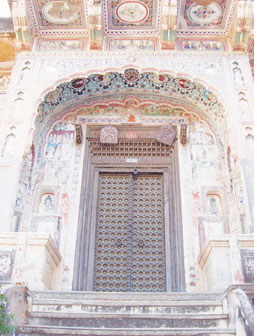
Warmth from the braziers placed around the lawns began to counter the chill in the air. The embers glowed fluorescent red and gold, and the stars looked down from a clear indigo sky. Magic floated around making an everyday routine sublime. Guests began to fill the lawns and soon after, a troupe of rustic musicians came into sight, led by an old man, with well oiled and curled handle bar mustachios. He carried two flares and was followed by musicians carrying a dholak, cymbals and other instruments. He sang a folk song in the local lingo moving from table to table, while the musicians followed, accompanying him with a lilting tune. We looked on enthralled and forgot to eat for a while, completely immersed in the music. The veil of a time bygone lifted for a while and led us into the embrace of a gracious past.

Regality prevailed over every aspect of the evening from the heart-warming hospitality to the regal buffet spread. We ate at a leisurely pace and watched the stars hang low in the sky. Guests began to leave, but we lingered, and as the lawns emptied we savoured the privacy accorded to us. We strung each moment, a precious pearl in the string of memories, sitting in companionable silence. The staff waited unobtrusive and uncomplaining in the periphery of the lawn…..
And for a day and a night, we were ‘royalty’.
The focal point of Mandawa, the castle, is built in mixed architectural styles that blends Rajput canopied terraces with Chinese pagodas and British turrets, using both dhandhala and stone visible in the turrets and arches.

Rivaling the castle in opulence are the havelis. The haveli was to the Bania what the fort was to the Rajput – his home, his status, his headquarters and his defense from the outside world. Most of the havelis are sprawling mansions with four courtyards covered in murals and frescoes within and without; paintings of Lord Krishna, Shivji, Ganeshji and other gods of the Hindu pantheon are interspersed with family portraits and lesser subjects like dancing women, hooka smoking men, and the more contemporary English men and women, cars, trams and airplanes.
The Gulab Ladia Haveli, one of the most palatial mansions of Mandawa is quite exceptional in its presentation of mural art. Gold leaf adorns most of the clothing of Lord Krishna on the walls. Latticed windows and carved wooden gates are evidence of the skilled workforce of the times. The Jhunjhunwala Haveli built in 1859 is no less outstanding a monument to traditional Rajasthani art. The epitome of the grandiose, the Goenka Double Haveli, is unique with its twin grand entrances; their outer facades featuring camels and horses among other subjects. The Poddars, Lohias, Ladhias, Chokhanis and other business tycoons, whose lines continue to this day, can trace their ancestry to the towns of Shekhawati to which their forefathers were drawn 300 years ago.


 [/column]
[/column]